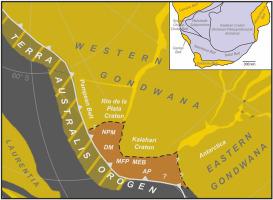More than 100 years of research on the origin of Patagonia
IF 1.5
4区 地球科学
Q3 GEOSCIENCES, MULTIDISCIPLINARY
引用次数: 0
Abstract
This work traces the historical development of ideas concerning the origin of Patagonia, considering alternative models and interpretations, and a discussion on the tectonic significance of the North Patagonian and Deseado massifs during the Paleozoic. Evidence indicates a common Paleozoic tectonomagmatic and metamorphic evolution for both the North Patagonian and Deseado massifs, which achieved their present-day configuration as the result of mainly Cenozoic tectonomagmatic processes that triggered uplift. On the other hand, these crustal domains were likely part of a rather large continental block, together with the Antarctic Peninsula, the Malvinas/Falkland Plateau, and the Maurice Ewing Bank, which was part of the western Kalahari Craton prior to Brasiliano–Pan-African collisions. Therefore, the late collision of the Kalahari Craton with the already amalgamated Western Gondwana was the most likely trigger of the juxtaposition of these African domains along the southern margin of the Río de la Plata Craton.

一百多年来对巴塔哥尼亚起源的研究
这项工作追溯了有关巴塔哥尼亚起源的思想的历史发展,考虑了不同的模型和解释,并讨论了古生代北巴塔哥尼亚和Deseado地块的构造意义。有证据表明,北巴塔哥尼亚地块和迪塞多地块具有共同的古生代构造岩浆和变质演化,主要是新生代构造岩浆作用引发隆升的结果。另一方面,这些地壳域可能是一个相当大的大陆块的一部分,连同南极半岛、马尔维纳斯群岛/福克兰高原和莫里斯尤因滩,后者在巴西-泛非碰撞之前是喀拉哈里克拉通西部的一部分。因此,卡拉哈里克拉通晚期与已经合并的西冈瓦纳大陆的碰撞最有可能是这些非洲大陆板块沿Río德拉普拉塔克拉通南缘并列的触发因素。
本文章由计算机程序翻译,如有差异,请以英文原文为准。
求助全文
约1分钟内获得全文
求助全文
来源期刊

Journal of South American Earth Sciences
地学-地球科学综合
CiteScore
3.70
自引率
22.20%
发文量
364
审稿时长
6-12 weeks
期刊介绍:
Papers must have a regional appeal and should present work of more than local significance. Research papers dealing with the regional geology of South American cratons and mobile belts, within the following research fields:
-Economic geology, metallogenesis and hydrocarbon genesis and reservoirs.
-Geophysics, geochemistry, volcanology, igneous and metamorphic petrology.
-Tectonics, neo- and seismotectonics and geodynamic modeling.
-Geomorphology, geological hazards, environmental geology, climate change in America and Antarctica, and soil research.
-Stratigraphy, sedimentology, structure and basin evolution.
-Paleontology, paleoecology, paleoclimatology and Quaternary geology.
New developments in already established regional projects and new initiatives dealing with the geology of the continent will be summarized and presented on a regular basis. Short notes, discussions, book reviews and conference and workshop reports will also be included when relevant.
 求助内容:
求助内容: 应助结果提醒方式:
应助结果提醒方式:


